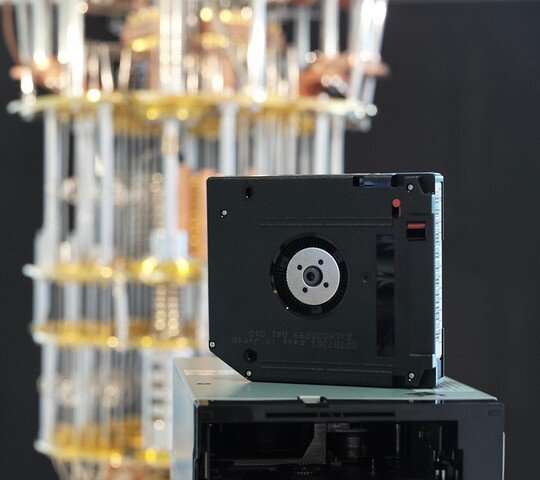Magnetically controlled device could deliver clot-reducing therapies in response to stroke or other brain blockages.
Get the latest international news and world events from around the world.


Physicists Outline an Ambitious Plan to Simulate Black Holes With Holograms
Black holes are some of the most powerful and fascinating phenomena in our Universe, but due to their tendency to swallow up anything nearby, getting up close to them for some detailed analysis isn’t possible right now.
Instead, scientists have put forward a proposal for how we might be able to model these massive, complex objects in the lab — using holograms.
While experiments haven’t yet been carried out, the researchers have put forward a theoretical framework for a black hole hologram that would allow us to test some of the more mysterious and elusive properties of black holes — specifically what happens to the laws of physics beyond its event horizon.


Quantum safe tape drive: IBM team eyes encryption future
This week a collaborative effort among computer scientists and academics to safeguard data is winning attention and it has quantum computing written all over it.
The Netherlands’ Centrum Wiskunde & Informatica (CWI), national research institute for mathematics and computer science, had the story: IBM Research developed “quantum-safe algorithms” for securing data. They have done so by working with international partners including CWI and Radboud University in the Netherlands.
IBM and partners share concerns that data protected by current encryption methods may become insecure within the next 10 to 30 years.

A deep learning technique for context-aware emotion recognition
A team of researchers at Yonsei University and École Polytechnique Fédérale de Lausanne (EPFL) has recently developed a new technique that can recognize emotions by analyzing people’s faces in images along with contextual features. They presented and outlined their deep learning-based architecture, called CAER-Net, in a paper pre-published on arXiv.
For several years, researchers worldwide have been trying to develop tools for automatically detecting human emotions by analyzing images, videos or audio clips. These tools could have numerous applications, for instance, improving robot-human interactions or helping doctors to identify signs of mental or neural disorders (e.g.„ based on atypical speech patterns, facial features, etc.).
So far, the majority of techniques for recognizing emotions in images have been based on the analysis of people’s facial expressions, essentially assuming that these expressions best convey humans’ emotional responses. As a result, most datasets for training and evaluating emotion recognition tools (e.g., the AFEW and FER2013 datasets) only contain cropped images of human faces.

Investigating the best features for predicting a movie’s genre and estimated budget
A team of researchers at the University of Virginia has recently carried out a large-scale analysis aimed at identifying features in film trailers that best predict a movie’s genre and estimated budget. In their study, outlined in a paper pre-published on arXiv, the researchers specifically compared the effectiveness of visual, audio, text, and metadata-based features.
“Video understanding is the next frontier after image understanding,” Vicente Ordonez, one of the researchers who carried out the study, told TechXplore. “However, much work on video understanding has so far focused on short clips with a human performing a single action. We wanted something longer, but there is also the issue of computational power. Video trailers seemed like an intermediate compromise, as they display a multitude of things, from scary to funny.”
Movie trailers are short and can easily be paired with movie descriptions. Ordonez and his colleagues realized that these characteristics make them ideal to investigate parallels between video and language.

Quantum engineering atomically smooth single-crystalline silver films
Ultra-low-loss metal films with high-quality single crystals are in demand as the perfect surface for nanophotonics and quantum information processing applications. Silver is by far the most preferred material due to low-loss at optical and near infrared (near-IR) frequencies. In a recent study now published on Scientific Reports, Ilya A. Rodionov and an interdisciplinary research team in Germany and Russia reported a two-step approach for electronic beam evaporation of atomically smooth single crystalline metal films. They proposed a method to establish thermodynamic control of the film growth kinetics at the atomic level in order to deposit state-of-the-art metal films.
The researchers deposited 35 to 100 nm thick, single-crystalline silver films with sub-100 picometer (pm) surface roughness with theoretically limited optical losses to form ultrahigh-Q nanophotonic devices. They experimentally estimated the contribution of material purity, material grain boundaries, surface roughness and crystallinity to the optical properties of metal films. The team demonstrated a fundamental two-step approach for single-crystalline growth of silver, gold and aluminum films to open new possibilities in nanophotonics, biotechnology and superconductive quantum technologies. The research team intends to adopt the method to synthesize other extremely low-loss single-crystalline metal films.
Optoelectronic devices with plasmonic effects for near-field manipulation, amplification and sub-wavelength integration can open new frontiers in nanophotonics, quantum optics and in quantum information. Yet, the ohmic losses associated in metals are a considerable challenge to develop a variety of useful plasmonic devices. Materials scientists have devoted research efforts to clarify the influence of metal film properties to develop high performance material platforms. Single-crystalline platforms and nanoscale structural alterations can prevent this problem by eliminating material-induced scattering losses. While silver is one of the best known plasmonic metals at optical and near-IR frequencies, the metal can be challenging for single-crystalline film growth.

Artificial intelligence uncovers new details about Old Master paintings
Artificial intelligence has been used to analyse high-resolution digital X-ray images of the world famous Ghent Altarpiece, as part of an investigative project led by UCL.
The finding is expected to improve our understanding of art masterpieces and provide new opportunities for art investigation, conservation and presentation.
Researchers from the National Gallery, Duke University and UCL worked with technical images acquired from the brothers Van Eyck’s Ghent Altarpiece, a large and complex 15th-century altarpiece in St Bavo’s Cathedral, Belgium.

Freight-train earthquake detectors, ion-trap quantum computers and the “dude wall” problem
If you’ve ever been wakened by the roar of a freight train – or waited at a level crossing for one to trundle by – you’ll be glad to know that these noisy vehicles have a new and potentially life-saving purpose: predicting earthquakes. As Hamish Johnston explains on this week’s podcast, freight trains generate surprisingly strong seismic waves, and changes in the velocity of these waves is an early sign of hazardous earthquake activity. Researchers in France, Belgium and the US studied the rumblings of freight trains running through California’s Coachella Valley and found that they could, in principle, be used to monitor the nearby San Jacinto fault.
Next on the podcast is Chris Monroe, an atomic physicist and quantum technologist whose start-up firm, Ion Q, is developing a quantum computer that uses trapped ions as qubits. In an interview with Physics World’s industry editor Margaret Harris, Monroe explains how Ion Q’s technology differs from classical computers, and describes how trapped ions execute quantum gates.
The third segment of the podcast focuses on the persistent lack of diversity in physics. In an interview, Jess Wade, a physicist at Imperial College London, discusses the scientific impact of this poor diversity and suggests ways to make the field more welcoming to members of underrepresented groups. Afterwards, our features editor Sarah Tesh, who commissioned Wade and Maryam Zarainghalam to write about this topic in the August issue of Physics World, talks about the portraits of white male scientists that adorn walls in many physics departments. These so-called “dude walls” honour important historical figures, but they also send out subtle signals about what a “great” physicist looks like.